It’s Simply an Advantage
According to many iconic leaders, being simple is hard, but it’s also an incredible advantage. So if you make time to make things simple, your customers will thank you.
The French philosopher and mathematician Blaise Pascal once penned a letter to a friend in which he wrote: If I had more time, I would have written a shorter letter.
This quote is quite famous and, like many well-known quotes, often gets attributed to other luminaries such as Abraham Lincoln or Winston Churchill. But what Pascal meant when he wrote those words was that he had simply scribbled down what he was thinking as he wrote rather than spend the time to plan and process his ideas before he picked up his quill and ink bottle.
Pascal of course couldn’t edit as easily as we can with the help of our word processing software, so he meandered and digressed as he scratched the words into his piece of parchment, which resulted in a longer and denser letter than he might have liked to have sent.
But this exact same thing happens all the time when it comes to designing our business processes and systems. When we don’t do the necessary work upfront to create a design that is simple and elegant, we end up building products and services that are complex and cluttered. Put another way: Simple is hard.
Simple is hard.
This is actually something that great business leaders understand quite well. Think about how Jeff Bezos helped design the way Amazon.com works- especially if you are an Amazon Prime member. Every time you return to purchase something, everything in your address book, credit card information and shipping preferences is all ready to go with literally one click of a button. It’s incredibly simple to use and it shouldn’t come as a surprise that when Amazon introduced one-click shopping, the company’s revenues skyrocketed.
But what might go unappreciated is how much work Bezos and his team put into making that design so simple. They very likely invested thousands of hours in user testing to streamline the process that we now benefit from. Again, simple is hard.
Consider also any Apple product you’ve ever handled. Not only are they gorgeous to look at, but they’re also incredibly intuitive to use, so much so that Apple famously doesn’t even ship user manuals. Apple products are so simple to use that even children can literally pick them up and operate them.
But if you know anything about Steve Jobs, you know that he was fanatical about design and he spent countless hours obsessing over even the most minute design detail as a way to simplify it and make it easy to use. Repeat after me: Simple is hard.
Simple is a competitive advantage.
Now think about the processes and systems in your business. How much time are you spending up front to make them simple and intuitive for your customers to use? Have you fallen into the trap of relying on a user manual as thick as your forearm while making the assumption that your customers will just figure it out?
It’s worth thinking about, especially if your competitors are offering an easier-to-use alternative. If you had to reenter all of your billing and shipping information every time you placed an online order, versus just clicking a button, where would you spend your money?
Or what kind of device would you rather buy: one that you can pick up and start using right out of the box or one that makes you fall asleep trying to pick your way through a user manual? Customers like simple. And simple wins in the marketplace.
Simple is hard, but it’s also an incredible competitive advantage. So make the time upfront to think hard and write a shorter letter; your customers will thank you.



